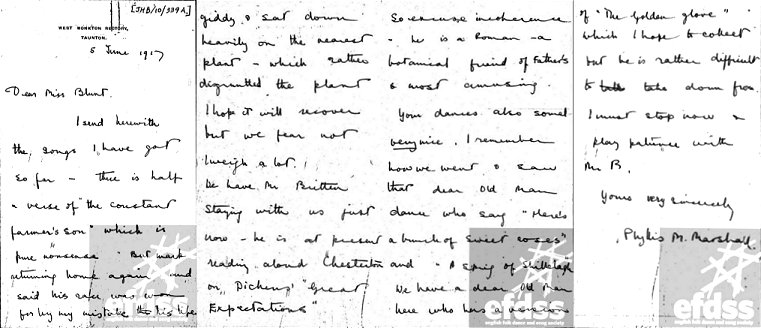
In the late 1970s Bob and Jacqueline Patten located another copy of Phyllis Marshall's manuscript books. These include other songs not included in the Blunt archive. Bob and Jackie's book A Somerset Scrapbook refers to Phyllis Marshall. This is now available as a CD ROM (MTCD252) from Musical Traditions at www.mtrecords.co.uk
The Blunt archive is now accessible via the web site www.vwml.org: 'Full English'. My thanks to the VWML at the outset for recent archive digitisation without which this piece would not have taken off.
The most important singer in Bathpool was Elizabeth Nation. This paper will examine her life and those of the other local singers. I will also explore Phyllis Marshall's life and her interest in traditional dance and song, in the context of the early twentieth century revival. I have included background information about the area, and I've listed the songs in the manuscript with short descriptions. Appendix 1 is a note about of Phyllis Marshall's manuscripts and transcriptions. All but three of the songs have been transcribed in Appendices 2 and 3. Appendix 4 is a transcription of her letter of June 1917 to Janet Blunt.
I make some observations about the importance of this collection and about Phyllis Marshall in the concluding paragraphs.
In his research for the article Mike Pickering had the opportunity to speak to men and women who had known Mrs Blunt as well as descendants of singers and dancers. Janet Blunt, according to a letter quoted by Mike Pickering, 'egged on [others] to do some hunting'. She was assisted, for example, by Phyllis Marshall, who was a student at Lady Margaret Hall, Oxford from 1909-1912, ande worked at the Bodleian library in the city until 1916.
In 1916-7 Phyllis Marshall sent a manuscript to Janet Blunt with several songs she collected in Bathpool, Somerset, which was part of the parish of West Monkton, then her family home. Three of the songs were published in the 1976 Journal, two noted from Mrs Nation (London Town/When First to London and Johnny Collishaw) and one from Mrs Murphy (Love and Liberty/Sweet Swansea). The article also included Horn Fair, which was unattributed, but in fact also sung by Mrs Nation, who was the 'star' singer of the area; she sang fifteen songs.
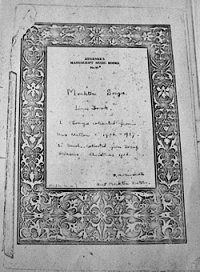 In Somerset Scrapbook, Bob and Jackie Patten wrote:
In Somerset Scrapbook, Bob and Jackie Patten wrote:
'Monkton Songs. Loan Book 2. P M Marshall West Monkton Rectory Taunton.'

Appendix 4 contains a full transcript of this letter.
The last two pages of this letter suggest that she corresponded regularly with Janet Blunt, and that there was another singer …' a dear old man'… who she was unable to collect from. The letter refers to James Britten, who I will refer to later in the context of her family life.
The second batch of songs was sent sometime after December 1919, and included repeat and partly revised versions of the earlier songs. Appendix 1 below gives details of the songs in both Loan Books and the Janet Blunt archive.
Elizabeth Nation sang these songs: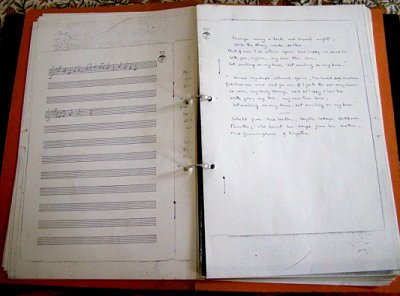
Cupid's Garden (Roud 297)
Mrs Nation's version of this widely noted song has been published in The New Penguin Book of English Folk Songs (Roud and Bishop) (Song no 23, p 58 with notes on its origin on page 394). It was noted from several Somerset singers by Cecil Sharp and also in Devon by Baring Gould. It's a well-known Copper family song and was in the repertoire of Harry Cox.
The Spotted Cow (Roud 956)
Another widely noted song. It can be found (in another version) in The New Penguin Book of English Folk Songs 2012 (Roud and Bishop), and it's another Copper family favourite. Mrs Nation's version does not have the usual first verse, which starts 'One Morning in the month of May…'
The British Man of War (Roud 372)
This was published in many 19th century broadsides, for example by Catnach (Frank Kidson collection). It was noted by Cecil Sharp from several Somerset singers including Captain Lewis of Minehead. Walter Pardon recorded the song in 1974 and it was released on his album A Proper Sort (Leader).
Where are you going? [Dabbling in the Dew] (Roud 298)
Cecil Sharp noted many versions of this song from Mendip, Chew Valley and South Somerset singers, and it was clearly popular in many other areas, including Sussex.
One Night as I Lay on my Bed (Roud 672)
A number of different versions of this song were noted by collectors George Gardiner and Henry Hammond in Dorset, Devon and Hampshire, but this may be the only one noted in Somerset. A version sung by Mrs Russell of Upwey Dorset to Hammond in 1907 was published in the 1959 edition of The Penguin Book of English Folk Songs (R Vaughan Williams and A L Lloyd eds) and again in the edition revised in 2003 by Malcolm Taylor. A version was published In Forty Long Miles (Foxworthy) that is very similar to that sung by Mrs Nation.
Blow the Winds I-O [Blow Away / Steal Away the Morning Dew] (Roud 11)
Cecil Sharp noted several versions of this song in his travels around Somerset in the early 1900s, and in 1916 published what became the 'standard' version later sung by many schoolchildren and choirs. Vaughan Williams used the tune for his folk song suite for military band in the 1920s. The text in Mrs Nation's version is similar to most others; its meaning may have been lost on collectors and schoolchildren in more innocent times!
The Pretty Plowboy (Roud 186)
Sharp noted a number of versions of this song in Somerset and Devon, as did other early 20th century collectors. Sharp published it in his collection of Somerset Folk Songs. Versions exist in Scotland (Daisy Chapman) East Anglia (Harry Cox and Walter Pardon) as well as Sussex, Ireland and the USA. Mrs Nation's is published in The New Penguin Book of English Folk Songs 2012 (Roud and Bishop) (Song 73, with notes on p 438)
The Constant Farmer's Son (Roud 675)
As with some other songs, Phyllis Marshall sent the text and music of this song to Janet Blunt more than once, and two examples can therefore be found in the Blunt archive, pages 322-324 and 355-359. It has been published in The New Penguin Book of English Folk Songs 2012 (Roud and Bishop) (Song 115 with notes on page 478). Cecil Sharp noted the song from Jack Barnard of Bridgwater (1907) and John Trump of North Petherton (1906), both places a few miles from Bathpool. Mrs Nation's version may be found in Forty Long Miles (Foxworthy) (page 12).
Lord Bateman (Roud 40)
Mrs Nation's fine version of this traditional ballad (Child no 53) was notated by Phyllis Marshall with four tune sections marked A, B, C and D. Cecil Sharp noted many versions in Somerset, though not from West Monkton! (Singer Lydia Wyatt referred to in the Roud Index at http://www.vwml.org/record/RoudFS/S182433 was from West Harptree, North Somerset)
Oh If I was but a Butterfly [The Irish Girl] (Roud 308)
This song is headed 'If' and 'Fragment' in the Janet Blunt archive (JHB/9/5 and JHB/10/13) and 'Fragment of a Love Song' in Phyllis Marshall's manuscript 'loan book no 1'. Some of the verses are the same as The Irish Girl. The third verse appears to have a missing line.
The Seeds of Love (Roud 3)
Mrs Nation's tune to this well-known song is an interesting variant. The 'lover' here is a 'saucy miner'. The last verse is:
Phyllis Marshall evidently had difficulty notating this song. Her first attempts include a few altered bar lines. The music starts with her time signature of '9/4?' which later changes to 5/4 in parts. This version only has the first three verses, and in the Janet Blunt archive the three verse version has been regularised to 5/4 with one bar in 6/4. There is a later version in the Blunt archive, with four verses, and a time signature of 9/4, with the penultimate bar in 5/4. It was published in 'Folk Music Journal' 1976 Vol 3/2, as part of Mike Pickering's article about Janet Blunt. (See also Appendix 1)
Johnny Collishaw (Roud 920)
This is the 'reluctant recruit' story also known as Captain Galligan (from Mrs Joiner of Chiswell Green Herts), Johnny Gallagher/Golicher or Pat Reilly. It's almost certainly from Ireland. It was published in Folk Music Journal 1976 Vol 3/2 in Mike Pickering's piece on Janet Blunt.
Midsummer's Evening (Roud 586)
This is a version of Shady Green Grove (Roud 2512). It was also collected by R Vaughan Williams from John Denny in Essex in 1904. Phyllis Marshall's note under the text and music in her manuscript book says: 'the words slightly altered'
Horn Fair (Roud 2482)
Few examples of this song are recorded on the Roud index; one or two are from Sussex, (collected by Vaughan Williams) and this is the only Somerset version. There are only three verses here. A link on http://mainlynorfolk.info/guvnor/songs/hornfair.html has a fuller text (though the reference to 'Kingsford Surrey' is incorrect - it was collected in Kingsfold West Sussex)
Mrs Ellen Millington sang these four songs: they are noted in Phyllis Marshall's 'loan book no 2' manuscript:
The Trees they do grow high (Roud 31)
Only the first two lines of the text and tune of this well-known ballad were noted.
The Dilly Song (Green Grow the Rushes-O) (Roud 133)
A version collected from Thomas Green of Wells Union by Cecil Sharp was published in Roud/Upton/Taylor (editors) Still Growing (EFDSS 2003) p.107
The Old Couple (Roud 491)
This song was published in a book of nursery rhymes and 'folk tales' by A Halliwell around 1870. It was noted in Sabine Baring Gould's manuscripts from two Devon singers in 1893. Mrs Millington's version is closely related to those noted in Baring Gould's manuscript and Cecil Sharp noted several Somerset versions between 1907 and 1913. Mrs Millington's version may have been 'cleaned up' for local taste. The version collected by H Hammond from Mrs Seale in 1906 and published in Frank Purslow's Marrow Bones (EFDS 1965 edition, p 71) is similar but includes an additional verse where the parish clerk 'was resolved with the old woman to lie'. Mrs Millington's words are included in the Appendix.
King Alfred's Three Sons (Roud 130)
More commonly known as King Arthur's Three Sons
There are many versions all involving a miller or a tailor or farmer, king or other 'authority figure'! Cecil Sharp noted two Somerset versions, one from Mrs Overd of Langport, and published in Still Growing (EFDSS 2003 Roud/Upton/Taylor, eds) p.68
There are seven other songs in Phyllis Marshall's manuscript:
Sweet Swansea (Roud 300/1612), also known here as Love and Liberty, was sung by Mrs Murphy and noted in both 'loan books'. In book 1 it's called Sweet Swansea and in book 2 Love and Liberty. Phyllis Marshall notes in the manuscript that Mrs Murphy 'learnt it in Cardiff from a Welsh girl'. It is similar to Ludlow singer May Bradley's superb version, recorded by Fred Hamer in about 1959. It was reissued on Musical Traditions CD MTCD349 in 2010.
The Hog Tub (Roud 1273) was sung by The White family. It was included in Halliwell's 1870 book of nursery rhymes and was also noted by Alfred Williams in Wiltshire.
The Banks of the Sweet Dundee (Roud 148) was sung by Mrs Thirza Burge. It was a favourite among traditional singers in Britain and across the Atlantic. Janet Blunt herself collected two Oxfordshire versions, one from Sam Newman in 1907, the other from John Venville in 1931.Hammond noted versions from Amos Ash and Jane Gulliver in Combe Florey, Somerset, and Cecil Sharp noted it from shanty man John Short of Watchet in 1914.
Mrs Burge's version is published in The New Penguin Book of English Folk Songs (Roud and Bishop) 2012 It's song no.58 with comprehensive notes on pages 425-427.
The Female Soldier (Roud 226) was sung by Mrs Rosa Duke. A popular song with many 20th century traditional singers like Harry Cox, Female Soldier was noted by collectors all over Britain. There are surprisingly few other versions noted in Somerset. Hammond noted a version from Jane Gulliver of Combe Florey, and the version from Elizabeth Smith of Copthorne Surrey is included in The New Penguin Book of English Folk Songs 2012 (Roud and Bishop) (Pages 18-19). The same song, with its first line, When I was young girl, can be found in the Blunt archive (JHB/9/10). It has the same tune and text as Mrs Duke's version.
Phyllis Marshall's footnote reads 'from Mrs Burge, Bathpool, now dead'. As Mrs Burge died in 1919,this indicates that Phyllis Marshall's 'fair copies' of the songs were sent to Janet Blunt some years later than the 1916-17 dates of collection noted on the cover of her 'loan book no 1'.
It's possible that The Female Soldier was sung by both Mrs Burge and Mrs Duke. They may well have known each other, with work connections at the paper mill as well as near village neighbours. It's also possible that Phyllis Marshall attributed the song to Mrs Burge in error, as it's not attributed to her in either of the two 'loan books', which may be a more contemporary record of the songs.
Twelve Bulls (Roud 21939) was sung by Mrs Thomas. This may be an unusual version of The Twelve Days of Christmas. There is only this one reference in the Roud index. Phyllis Marshall's manuscript records that Mrs Thomas 'learnt it as a child. She is now 83.'.
The Dark Eyed Sailor (Roud 265). The manuscript is unclear, but it's possible that Mrs Millington was the singer here. It is very similar to many other versions, including one from William Nott of Meshaw Devon, noted by Cecil Sharp and published in Still Growing (pages 64-65). Janet Blunt noted the song from Mrs Woodfield of West Adderbury, in 1912 or 1913.
Josef's Carol. This is a Christmas Carol from Josef Sciaens who was probably a visitor to the Rectory from Belgium at Christmas 1916.
Horn Fair, Love and Liberty/Sweet Swansea and Johnny Collishaw were published in Folk Music Journal, volume 3 no.2 1976. In the same year, 23 songs from the Blunt archive were published as Forty Long Miles by Tony Foxworthy under the Galliard/EFDSS imprint, with music transcriptions by John Brune. The set included Mrs Nation's Constant Farmer's Son and a shortened, unattributed, version of One Night as I lay on my bed. In 2012 The New Penguin Book of English Folk Songs included The Banks of the Sweet Dundee, The Constant Farmer's Son, The Pretty Ploughboy and Cupid's Garden.
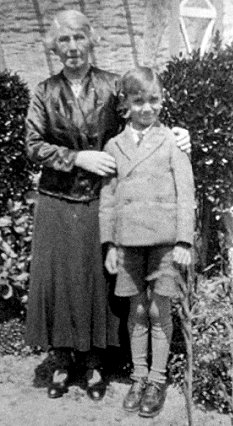 Mrs Elizabeth Nation 1864-1954
Mrs Elizabeth Nation 1864-1954
The most important singer noted by Phyllis Marshall in Bathpool was Elizabeth Nation.
She is listed in the 1911 census for Bathpool, aged 47, living at Laurel Cottages with her husband Fred, also 47, who worked as a farm labourer. She was born Florence Elizabeth Gunningham at Kingston St Mary, a few miles north of Taunton in February 1864. The parish record is unclear, but the birth date was between 21st and 28th February. Her mother was Mary Ann Gunningham (née Martin) and her father was John Gunningham who was an agricultural labourer. They were both born in Kingston.
Elizabeth Nation/Gunningham had 4 brothers and 2 sisters. In 1851 her mother Mary Ann Martin was living in Kingston village, the eldest daughter of Peter and Ann Martin. Her father was an agricultural labourer aged 52, born 1799 in Broomfield. Mary Ann Martin was born in 1836 and was already at work labouring on a farm at 15 years of age. Her sister Emma aged 13 also worked on a farm, and there were two more sisters, Sarah (4) and Harriet (8). By 1901 Mary and John Gunningham were listed on the census at Bobbetts, a farm, at Kingston St Mary with their son Ernest. Both father and son were noted as farm labourers, though John was by then 74 years of age. Bobbetts farm was also known as Grove's, near Ilebeare, north of Norton Fitzwarren.
In 1891 Elizabeth Gunningham was in service to Mr William Adams of 59, East Reach, Taunton. She was the only servant in the house. On 5th March 1892, in Kingston St Mary, she married Fred Nation, who was a groom from Bishops Lydeard, the village west of Kingston close to the Quantock Hills. He was born between October and December 1862; his father Isaac was a coachman.
By 1901 Elizabeth and Fred Nation they were living in Bawdrip Somerset, east of Bridgwater, where Fred was working as a carter on a farm. They now had two children, Clifford, born 1893, and Lily Rose, born 1895.
Both Fred Nation and his son Clifford served in the army in the First World War but neither saw action overseas. Fred joined the Territorials, although he was over the maximum age for recruits, and he left aged 50. Clifford joined the army in 1911 in the RFA 5th division and was then in the Royal Engineers, at Bulford barracks aged 19. He received the 1914 star, the War Medal and Victory medal.
Clifford Nation married Beulah Florence Dymer. They had three children, including daughter Doris and son Fred (junior). The family lived at Durrington Wiltshire and Doris was born there in 1921, when Clifford was in the army. Doris later married Leonard Aston of Goosenford near Cheddon Fitzpaine, to the north west of West Monkton, and moved there.
Fred Nation died on 26th June 1924, aged 59, and Elizabeth Nation moved to the almshouses in the Bathpool parish. An article in West Monkton Then and Now describes how the family came to be back in Bathpool:
Doris Nation/Aston worked at Pearsalls Silk factory at East St Taunton, then in service at The Avenue in the town. The article continues (Pages 108-9):
Elizabeth and Fred's daughter Lily Rose Nation worked as a domestic servant at the age of 15 in 1911 at the household of merchant Joseph Kingsley at Leighton, The Avenue Taunton. In 1919 she married George Smith in Taunton. In 1954 she was living at Coronation Road Bridgwater at the time of her mother's death on 22nd November that year aged 90, at number 4 The Almshouses, West Monkton.
Mrs Rosa Duke
In the second of her loan book manuscripts, Phyllis Marshall noted The Female Soldier, sung by Mrs Duke of Hyde Lane Bathpool. Rosa Duke is listed in the 1911 census at Laburnum Terrace Creech St Michael, aged 36 years, born in West Monkton and working as a finisher at a paper mill. Her husband William, 38, was a stationery stoker at the mill. He was born in Creech St Michael, a few miles east of Bathpool, at one end of Hyde Lane close to the Bridgwater to Taunton Canal. The mill there was probably the main industry and employer. Rosa and William Duke had one daughter Viva aged 13 and two sons William 9 and Herbert 7, all born in Creech St Michael.
Mrs Duke was born Rosa Horrill in West Monkton in 1875. Her mother Elizabeth and both brothers were also from West Monkton. The 1891 census records her, aged 16, working as a paper sorter at the mill. Rosa's father William was originally from Chumleigh, north of Dartmoor in Devon. Her brother Francis worked at the mill as a paper sorter. On 19th December 1896 she married William Duke, then a labourer. Both were living at Creech St Michael. It is possible that she knew one of the other Bathpool singers, Thirza Burge, who had also worked at the mill.
Mrs Thirza Burge
Mrs Burge sang The Banks of the Sweet Dundee, noted in the second loan book. She was born in West Monkton in 1865 and is listed in the 1911 census, aged 46, married to William Burge of Bathpool, originally from Stogumber, Somerset, working as a carter and coal merchant. Mrs Burge's occupation is listed as 'marine stores', which suggests she may have been running a small business in the village, possibly associated with the canal trade. The three eldest children, Thirza Ada, 18, William Ernest, 16, and Henrietta, aged 14, were all working at the Creech St Michael paper mill, the daughters as paper sorters and William junior as a paper coating hand. There were four more daughters aged 14, 12, 10 and 3, and another son aged 5.
In 1891, aged 25, Mrs Burge worked in the paper mill as a sorter. Her husband was an agricultural labourer. Mrs and Mrs Burge had therefore been in the area for over 20 years before the First World War. Thirza Burge died in 1919 and was buried at West Monkton on 2nd December 1919. The burial was overseen by the Rector G T Miller, who took over after Rev Marshall, Phyllis's father, left the parish.
Mrs Ellen Millington
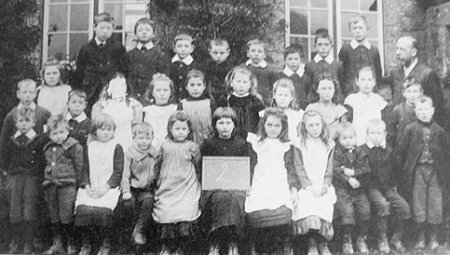 Ellen Millington was a teacher in the West Monkton and Bathpool village schools when Phyllis Marshall noted four songs from her. Her husband John was the head teacher at the school until 1921.They were both stalwart workers at West Monkton parish church, St Augustine's, throughout their time in the village. They lived at The Croft, Monkton Heathfield, when the songs were collected, and the house remained the family home until their daughter Edith Mary died in 1971.
Ellen Millington was a teacher in the West Monkton and Bathpool village schools when Phyllis Marshall noted four songs from her. Her husband John was the head teacher at the school until 1921.They were both stalwart workers at West Monkton parish church, St Augustine's, throughout their time in the village. They lived at The Croft, Monkton Heathfield, when the songs were collected, and the house remained the family home until their daughter Edith Mary died in 1971.
Ellen Millington was born Ellen Rogers in 1866, in Taunton, to William Rogers (a cooper, born in 1826) and his wife Eliza, born in 1825. Her brother, also William, was 5 years older. In 1871 they lived at 22 East Reach Taunton. Her father, who was born in Cothelstone, died before the next census in 1881. By then, the household included a lodger, Henry Wilmington, a 37 year old baker.
Ellen Rogers married John Millington in Taunton in 1891. John Millington had been the census enumerator for Bathpool that year and was a teacher at the national school at West Monkton. His family were from Worcestershire, John from Northfield and his mother from Cradley. The Millingtons lived at Orchard Cottage Monkton Heathfield. By 1901 they had moved to The Croft, Yalland Hill with daughter Edith, aged 7, and John's widowed mother Phebe.
Ellen Millington was an organiser for the Girls Friendly Society for over 30 years. She supervised the West Monkton branch. Phyllis Marshall also worked for the society and was Head of the Members Department in Bath and Wells, LLandaff and Monmouth dioceses from 1917-1925. It's likely that they knew each other well and may have continued their association after Phyllis Marshall moved from Somerset to Tidenham in Gloucestershire. Ellen Millington died in December 1936 and her burial at West Monkton is recorded in the parish register on 9th January 1937. The parish magazine carried a short tribute to her life and work.
The West Monkton parish magazines show that Mr and Mrs Millington and their daughter played a significant part in the life of St Augustine's church. John was a churchwarden for 25 years and also a Sunday School teacher. He was an active member of the Taunton and West Somerset branch of the National Union of Teachers. He had been associated with Bathpool All Saints church since its inception and had been a choirmaster. The parish magazine carried a tribute to him after his death on April 30th 1939, aged 83. An obituary also appeared in the Somerset County Herald for May 6th that year. The article was headed 'A useful life closes', and noted that there were few activities in the village that John Millington did not engage, be it cricket, local history, music teaching, carpentry, secretary of the local flower show, sending parcels to troops in the First World War, and organising the Bathpool and Monkton reading rooms. He represented the church at ecumenical conferences, and took a full part in church activities like the choir suppers. He was for a time an administrator of the Spital Almshouses, and helped organise the building of the new almshouses as well as saving the old building from demolition. Truly a pillar of local life from the end of the nineteenth century to his last days!
Ellen's daughter Edith Mary Millington also played a major part in church life. She became the deputy organist, taking a carol service in 1941 as well as at a later harvest festival. Like her parents, she was a teacher. She was active in the Women's Institute in the 1960s and also became clerk to the trustees of the Spital Almshouses after the move to their new building. She wrote a short history of West Monkton Our Parish of West Monkton, a copy of which may be found at the Somerset Heritage Centre, Taunton. She died in November 1971 aged 78.
Mrs Murphy
Phyllis Marshall's notes give no details about the singer of Love and Liberty / Sweet Swansea, Mrs Murphy. A note in the manuscript says she had learned the song 'from a Welsh girl in Cardiff'. This could suggest that she had travelled from her original home.
The 1911 census for West Monkton or neighbouring parishes do not list a Mrs Murphy, but there was a Mary Murphy boarding as a housekeeper at 2 Paul Street Gardens, Taunton. She was 58 and born in Dublin. The head of the household was Walter Richards, 49, a cab driver. It's possible that this Mrs Murphy worked later in West Monkton, but it is unlikely that this can be confirmed.
Mrs Thomas
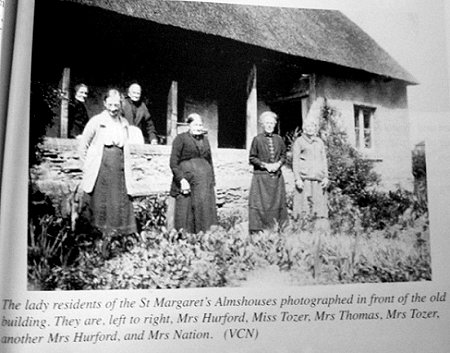 Phyllis Marshall noted one song, Twelve Bulls, from Mrs Thomas, said to be aged 83. The 1911 census records Mrs Ann Thomas aged 74, a pensioner born 1837 living in 2 rooms in Bathpool at an unspecified address, but probably at Spital Almshouses.
Phyllis Marshall noted one song, Twelve Bulls, from Mrs Thomas, said to be aged 83. The 1911 census records Mrs Ann Thomas aged 74, a pensioner born 1837 living in 2 rooms in Bathpool at an unspecified address, but probably at Spital Almshouses.
The West Monkton parish records have an entry for the burial of Annie Thomas on 25th January 1936 aged 99 at 7 Spittle (sic) Almshouses. We may assume her to be the singer, although there is a discrepancy about her age; Phyllis Marshall may have overestimated her age in her manuscript note.
The 1901 census records an Annie Thomas widow aged 58 working and living as a florist at Church Causeway Yatton, and born in West Monkton. It's possible that this is the same person. There is no Ann Thomas recorded on the 1891 census for West Monkton or Bathpool. It's possible that she moved from the village as a young woman and returned there after 1901 to take advantage of the charitable accommodation at the Spital almshouse.
In the booklet West Monkton Then and Now (2000) p 109, there is a photograph of the last residents of the old Almhouses (St Margarets), probably dating from the 1930s, taken in front of the building, just before Mrs Thomas died. All the residents are women, and Mrs Thomas is pictured third from the left. Also seen at the front right is Elizabeth Nation.
The White Family
Phyllis Marshall's manuscript book (Loan Book 1) describes The Hog Tub as 'White family song', but there is no further information about the singers.
The 1911 census lists two White families near to West Monkton. The first was at Leacroft Farm. The farmer was John White and his wife was Elizabeth White, both aged 63 and born in Devon. They had three daughters in their 30s, Florrie (who worked at home), Nellie (a 'fancy needleworker') and Mabel who worked in a dairy; a groom, James Saunders, aged 26, from Wiveliscombe also lived at the farm.
It is more likely however that the singing family was that of George White, aged 46, a farm bailiff, born in Evercreech, who lived in Bathpool with his family. His wife was Annie White originally from Yeovil aged 43. There were three sons, John 19 a milkman, Wedward 17, and George 14, who were both farm labourers. Two more sons Pretoria and Septimus were of school age, as well as daughter Dora aged 12.
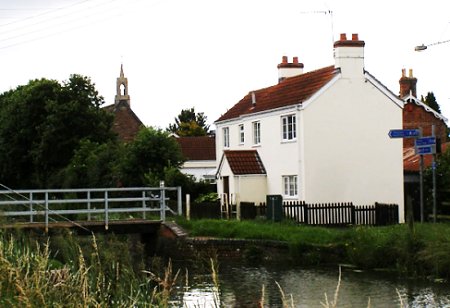 Phyllis Marshall was the daughter of the Rector of West Monkton, the Rev Edward Shearburn Marshall. He was minister at the local Anglican church within the Bath and Wells diocese, St Augustine's, from 1904 until 1919.The parish includes the villages of Bathpool, Monkton Heathfield and Gotton, and is about four miles north west of Taunton and seven miles south west of Bridgwater. Bathpool had a mission church, All Saints, which was part of St Augustine's, and a congregational church. During the twentieth century, the parish boundaries changed at its western edge, and part of it was included in the Borough of Taunton.
Phyllis Marshall was the daughter of the Rector of West Monkton, the Rev Edward Shearburn Marshall. He was minister at the local Anglican church within the Bath and Wells diocese, St Augustine's, from 1904 until 1919.The parish includes the villages of Bathpool, Monkton Heathfield and Gotton, and is about four miles north west of Taunton and seven miles south west of Bridgwater. Bathpool had a mission church, All Saints, which was part of St Augustine's, and a congregational church. During the twentieth century, the parish boundaries changed at its western edge, and part of it was included in the Borough of Taunton.
When Phyllis Marshall lived there, the rectory was a large house in the gardens below the church. In about 1933 the house was sold and it is now a private residence known as Glebe House. The rectory is now adjacent to the church.
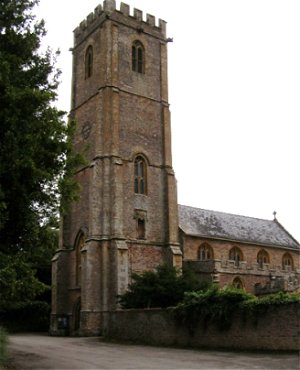 In the early twentieth century, the area was largely agricultural, but the nineteenth century saw the building of the Great Western Railway, which runs through the area, close to the Bridgwater to Taunton canal and to the River Tone en route to the River Parrett which flows into the Bristol Channel. The canal and river run through Bathpool and Creech St Michael. The abundance of water gave rise to flour mills and the Creech St Michael paper mill, built in 1875.
In the early twentieth century, the area was largely agricultural, but the nineteenth century saw the building of the Great Western Railway, which runs through the area, close to the Bridgwater to Taunton canal and to the River Tone en route to the River Parrett which flows into the Bristol Channel. The canal and river run through Bathpool and Creech St Michael. The abundance of water gave rise to flour mills and the Creech St Michael paper mill, built in 1875.
Bathpool had a saw mill, but a corn mill, owned by the Redler family, was destroyed by fire in 1915, having suffered previous fires in the nineteenth century. Flour dust and an overheated bearing were the cause. (West Monkton Then and Now, page 34). The mill used local spring water and steam was produced from Somerset coal.
Kelly's Directory for 1914 gives the population as 937 in the civil parish, scattered over what was a relatively large district. It refers to several stone quarries in the area, and tells us that the chief crops were wheat, barley and roots. The principal landowners in the parish were Lt. Col. W. O. Meade King, whose residence was Walford House, and Viscount Portman who was lord of the manor. Kelly's lists several farmers including Cecil Gulliford, possibly related to the Gullifords from Combe Florey, (where Jane Gulliford/Gulliver sang to Cecil Sharp), and William Wyatt of Procter's Farm, whose widow gave three tunes to Cecil Sharp when he visited West Monkton that year.
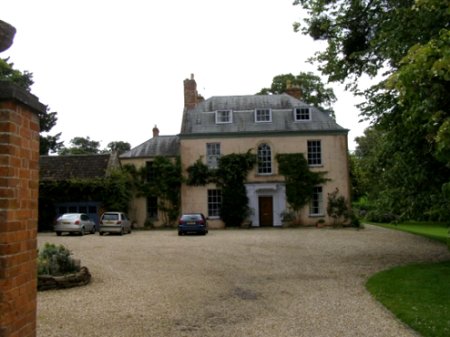
Kelly's lists the Monkton Heathfield elementary school, built in 1845, where Mr and Mrs Millington were the teachers. There were 163 children, but the average attendance was 127.
The main Bridgwater to Taunton Rd (now the A38) ran through Bathpool and the directory listed a coal merchant, a florist, a motor and cycle dealer, and a greengrocer.
West Monkton and Bathpool life, like many Somerset villages, often centred on the church and associated school, with seasonal ceremonies and annual friendly society occasions like the 'Club Walk' referred to in Edith Millington's pamphlet. This was a procession with charitable gifts and entertainment. The close connection between the church and the school is clear; both teachers, Mr and Mrs Millington, were active workers for the church, and John Millington played a significant role in the establishment of Bathpool All Saints church in the 1890s. The Rev Roynon's history of St Augustine's relates how John Millington organised and helped in the carpentry work to the pews in the early part of the twentieth century. He was also at one time the choirmaster. In 1935 he was one of two churchwardens, the other being Sir W. O. Meade King. His daughter Edith was, for a time, deputy church organist.
Rev Maurice Roynon's 1968 booklet on the parish notes that:
The Spital Almshouses
Both Elizabeth Nation and Mrs Thomas, two of the Bathpool singers, ended their days as residents of the local Spital Almshouses. Dating back to the 12th century, the almhouses were probably the most important charity supported by St Augustine's West Monkton parish. The Chairman of the trustees has always been the Rector of West Monkton.
The almshouses were originally built as a Leper Hospital when they were at Hamilton Road, East Reach Taunton (then within the parish boundary, now part of Taunton). They later became accommodation for the elderly of the parish. The 1891 census shows that there were seven separate dwellings within the building. Four of them were occupied by elderly or single women and a married couple lived in another. Mrs Thomas was one of the residents when Phyllis Marshall noted Twelve Bulls from her in 1916.
Mrs Nation moved into the old almshouses from Baytree Cottage when she was widowed after 1924. At that time the original building was falling into disrepair and during the 1930s plans were made for a new building, which opened in 1938. The booklet West Monkton Then and Now has a drawing of the old Hamilton Road almshouses (page 30). The new almshouses, known as Spital Row, contain four modern brick built bungalows.
Creech St Michael Paper Mill
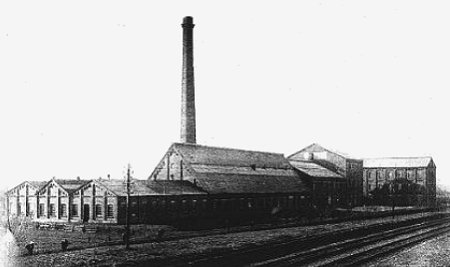
Creech St Michael is the neighbouring parish to West Monkton to the east. The paper mill bordered the parish of Ruishton, south of Creech.
Owned by the Somerville family, Creech St Michael paper mill opened in 1875 and lasted until 1993 when production ceased, having at one time been owned by the British Printing Corporation (once part of Robert Maxwell's group of companies). It was built between the GWR railway line and the River Tone, just south of the village. A spur railway line was used to bring coal and other materials to the plant. There had previously been a mill close by to extract oil from philberts (hazelnuts).
The Somerville's ran mills at Bitton, near Bristol, and at Penicuik in Scotland, and some of the workforce came from the other plants. The mill needed a large workforce and many local people worked there. As mentioned above, several members of the Burge and Duke family worked there from the late nineteenth century until the First World War.
The mill attracted political controversy during 1914 when Arthur Henderson MP raised a question in the House of Commons alleging that the firm paid low wages. The company denied this, and contemporary records suggest that the evidence for low wages was mixed. Henderson was a founder member of the new Labour Party, but R. Somerville, the mill owner, was chairman of Creech St Michael Conservative Association ; hence the controversy! Somerville built a house for his family at Ruishton. The company employed young people just out of school. During the nineteenth century, a succession of Factories Acts came into force to regulate the employment of children. In the Accounts and Day Book for the mill (page 294) we find this:
No boy must be worked at night under 16 years of age. But a boy from 14 to 16 years of age can start at 5 a.m. or work to 10 p.m but not for longer than 12 hours.
No boy under 18 must work over 12 hours consecutively or work two consecutive weeks on night shift. He must also have a meal from 8.30-9 a.m and from 1 to 2 p.m.
An article by Gwyneth Leighton at www.creechstmichael.net/about/paper-mill explains:
Creech Mill has always had its fair share of problems over the years as may have been expected particularly in the earlier days when factory safety standards were less rigorous than those of today. There are several reports of disasters and deaths, although surprisingly there are no strikes recorded.
At the time of the 1891 census, the family lived at Milford Vicarage, Mousehill, Witley, Oxted Green.
Phyllis's brother Edward Foster Marshall was born a year earlier and in 1891, Phyllis's sister, Gertrude Isobel, was born. The household was completed by four women servants, aged between 14 and 41, two of whom worked as nursemaids. On 28th May 1893, a son, John Wordsworth Marshall was born, but sadly he died in August that year.
By 1901 the Marshall family had moved to The Rectory at Lavington-cum-Graffham, near Midhurst in Sussex, where Rev Marshall was the Church of England minister.The Rectory employed 5 women staff, a parlour maid, a cook, a housemaid, a kitchen maid, and a nurse, Annie Thornton, who had been with the family at Witley. Phyllis's brother, Edward Foster Marshall, is not listed on the 1901 census and was probably at boarding school. In 1902 Edward Marshall became the local minister in Keevil Wiltshire. The family moved again in 1904 to West Monkton Somerset, where Edward Marshall was Rector until the autumn of 1919, the year he died aged 61.
In 1911, the Marshall household continued to employ staff, and the census records the family as Edward and Fanny Marshall, both 53, son Edward Foster Marshall, 22, an Oxford student, and daughters Phyllis Mary, 21 (also an Oxford student) and Gertrude Isobel Marshall, 20. There were four servants: Catherine Manderville 44 (cook) from Surrey, Mary Beagley 27 (parlour maid), from Surrey, and Rose Binning 25 (Housemaid) and Elsie Dyer 15 (kitchen maid), both from Somerset. A visitor was also recorded, an artist, Robert Dudley 42, from Kensington.
In the annual journal produced by the college, The Brown Book, Lady Margaret Hall Chronicle December 1911(pp.35-36), there was an account of the performance:
After graduation Phyllis Marshall worked on catalogue revision at the Bodleian Library (Oxford) between 1912 and 1916.During this time she lived at Woodstock Road Oxford and became enthused by the new interest in Morris dancing in and around the city.
The article shows, from contemporary references, that interest in the revival of traditional dance, including Morris, was well under way in Oxford when Phyllis Marshall was a student at Lady Margaret Hall. By 1909 both Mary Neal, as organiser of the London Esperance Society, and Cecil Sharp had addressed gatherings in Oxford, with demonstrations by William Kimber, amongst others. School children were being instructed in folk dance. A local society 'For the revival of the Folk Dance' was set up.
The Oxford Journal of 12th June 1912 carried photographs showing a display of 'Old English and Morris Dancing, given by the Oxford branch [of the EFDS] at Thame tennis court'.
Roy Judge's article refers to a photograph in the newspaper of Miss Daking 'who ably managed the display'. Caroline 'Daisy' Daking taught dancing to local girls in Oxford, and later to troops in the First World War and to schoolgirls in East London. The web site: www.ju90.co.uk/ctfolk/ctfolk1.htm has more information about this.
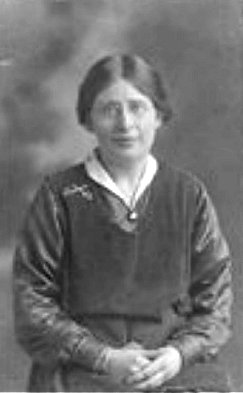 A biography of Daisy Daking may be found in The Fine Companion by Hilary Clare (The Elsie Oxenham Society/Abbey Chronicle 2011). Daking stayed at Oxford between January 1912 and the summer of 1914 'lodging at 11 Woodstock Road and making many friends, particularly perhaps the Sidgwick family' (Clare p.11). Phyllis Marshall also lived at 11 Woodstock Road at this time. Charlotte Sidgwick, who lived at 64 Woodstock Road, was an early secretary of the Oxford Folk Dance Society.
A biography of Daisy Daking may be found in The Fine Companion by Hilary Clare (The Elsie Oxenham Society/Abbey Chronicle 2011). Daking stayed at Oxford between January 1912 and the summer of 1914 'lodging at 11 Woodstock Road and making many friends, particularly perhaps the Sidgwick family' (Clare p.11). Phyllis Marshall also lived at 11 Woodstock Road at this time. Charlotte Sidgwick, who lived at 64 Woodstock Road, was an early secretary of the Oxford Folk Dance Society.
In June 1913, The Oxford Journal published more photographs of Morris dancing at a garden party at Somerville College. The same year, Oxford University Drama Society put on a performance of Thomas Dekker's Elizabethan play Shoemaker's Holiday; it included Morris dances performed by both undergraduates and dons who were members of the Folk Dance Society. (Judge, p8)
By this time the University had its own Folk Dance Society.
Roy Judge's article has this account of events in 1913, said to have been written by Frances Griffiths, a Somerville college student:
An extant dance has been found and recorded by Miss Phyllis Marshall in Somerset. It has received Mr Sharp's sanction, as genuine tradition. `The Breast Knot' is its title, and the tune is now also recorded and sent in to the Director.
The Term wound up with a general dance Saturday Night, June 14, on the High School Games' Club Ground, by kind permission of the authorities. It lasted from 6 to 9 p.m. About 70 persons were present, chiefly Miss Daking's class-pupils. Violin and piccolo were planted in the centre of the ground, and lighted when it became necessary by a Japanese lantern held over the players. The University Morris team did the Flamborough Sword-Dance midway. The Irish Trot expanded (owing to roominess) into new patterns. In The Buttery in the dark, everyone present joined, and so went home.'
The southern end of Woodstock Road is close to Somerville College, a short walk from Lady Margaret Hall, where Phyllis Marshall was a student. Both colleges were for women only at this time.
In August 1913, during the holiday period, the local EFDS branch gave a Morris demonstration for Summer Students at Lady Margaret Hall. William Kimber played the concertina and Daisy Daking was there. There was apparently another downpour! The report did not mention whether Phyllis Marshall was present.
Cecil Sharp visited West Monkton on 5th June 1914 and noted three tunes and dances from Mrs Wyatt. He noted The Breast Knot again (now numbered FT 2963), and added The Foxhunter (a jig) and Cross Hands to his collection. I have not been able to find out if Phyllis Marshall invited Sharp to the village, but it's likely that his visit was arranged with her help. Sharp's notes to The Foxhunter confirm his interest in the context of village music and dance and the people he collected from. He writes:
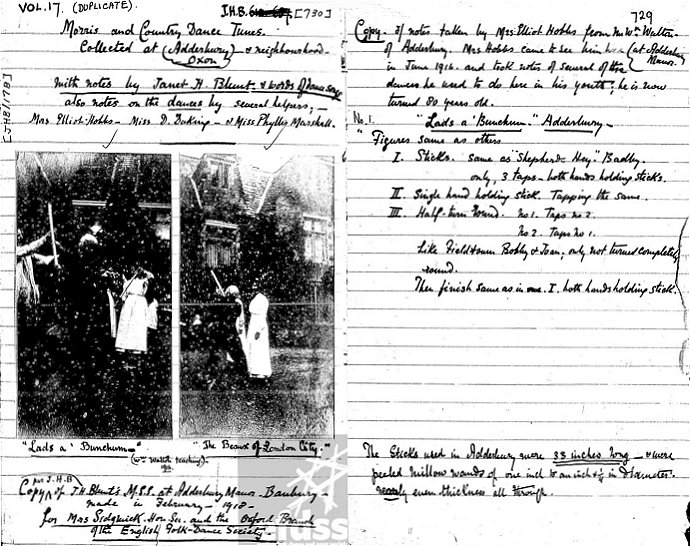
From the Janet Blunt archive, showing Phyllis Marshall as assisting her with dance collection, with Mrs Eliot Hobbs and Daisy Daking.
Phyllis Marshall is not in the accompanying photographs.
The manuscript records show how Phyllis Marshall (with Daisy Daking) helped Janet Blunt with dance collection and notation during January and February 1914. At Adderbury, she noted these dances:
Edward, Phyllis's grandfather, married Caroline Shearburn and in 1861 they were living at Beechcroft Oatlands Place, Walton on Thames, with their two sons Edward Shearburn Marshall and Eddon Marshall (aged 3 and 1 respectively). Caroline Shearburn was born in 1823 in Snaith near Goole East Yorkshire. Her father William was a solicitor.
Phyllis's grandfather was in the civil service in the War Office, probably in a senior position. The five household domestic staff included a cowman. By 1871 he had died and the Marshalls were living at Chilworth St, Paddington London. In 1881 Phyllis's father Edward Shearburn Marshall was an undergraduate at Brasenose College Oxford University. He studied Classics, Modernism and History and an MA in 1884.
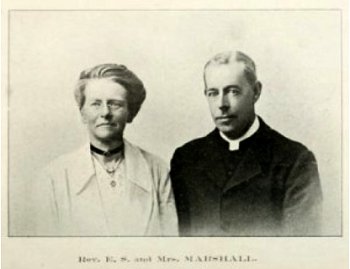
The Journal of Botany (Volume 58 Jan 1920) carried Edward Marshall's obituary, written by the editor James Britten, the family friend mentioned in Phyllis Marshall's 1917 letter to Janet Blunt. Britten shows that both Edward and Fanny Marshall were keen botanists. Edward published works on the flora of Somerset, Bristol and Gloucestershire. They travelled to Ireland on botanical trips.
Britten had been a founder member of the Folk Lore Society, but later concentrated his interests around botany, and does not seem to have been involved in song collection. He was associated with the Natural History Museum in London.
Britten (a 'Roman' according to Phyllis's 1917 letter) described Edward Marshall as 'High Church':
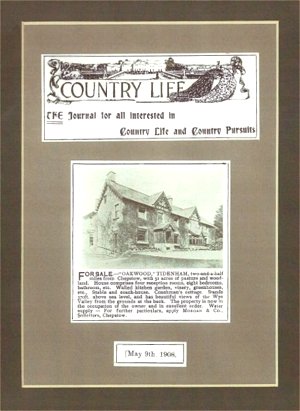
According to James Britten, Edward Marshall had intended to devote his retirement to botany and plant collection. However, his wife Fanny died on 5th November 1919 and Edward himself on 28th November 1919. Both were buried at Tidenham parish church, where the minister was Rev Reginald Steer.
Phyllis was left her father's estate worth over £31000 in 1919. This included the income (the benefice) due to his former office from various Somerset parishes. In November 1968, this part of the estate reverted back to the Diocese of Bath and Wells.
Phyllis Marshall and her sister Gertrude moved to Offa's Dyke at the same time as her parents. Gertrude later settled at Tutshill in the parish, and stayed there without marrying to the end of her life.
In April 1925, Phyllis paid for a stained glass window to be installed in Tidenham parish church in memory of her parents, at a cost of £600. It is inscribed 'To the glory of God and in loving memory of Edward Shearburn Marshall, priest, and Fanny Isobel Marshall, his wife' The window is a triptych design matching the three windows under gothic arches, with a centre image of Mary and Jesus.
Phyllis's brother Edward Foster Marshall was a civil servant in Ceylon; he married Agnes Whateley Thomson at Barrow on Soar Leicestershire on 22nd January 1920. He had interests in a tea plantation. A child was baptised at the Holy Trinity Church at Nuwara Eliya, in the central hills in Ceylon. Following independence after the Second World War, Edward returned to Britain, and a new wing was built at Offa's Dyke for his family. Apparently he could not settle there, and returned to Sri Lanka as a plantation manager.
In February 1928 Phyllis became the joint owner, with Walter Bounds, of Mapleford Engine Colliery, Clements End, Sling, south of Coleford. It became part of the nationalised coal industry in 1951.
The Minute Book of the Coleford group of the Girls Friendly Society records that the July 21st 1928 Festival at Coleford:
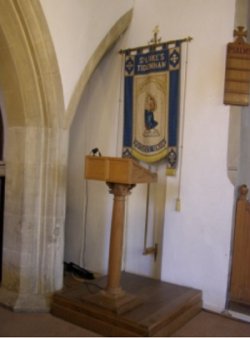 It's possible that Phyllis Marshall may have been active with the Society in the Forest of Dean, although the Tidenham group had withdrawn from the Coleford branch in 1913. In July 1934 Mary Powell, the housekeeper at Offa's Dyke, died suddenly after a heart attack at the age of 65.
It's possible that Phyllis Marshall may have been active with the Society in the Forest of Dean, although the Tidenham group had withdrawn from the Coleford branch in 1913. In July 1934 Mary Powell, the housekeeper at Offa's Dyke, died suddenly after a heart attack at the age of 65.
Phyllis Marshall was a stalwart of both Tidenham and Tutshill church life; she played the organ, organised Sunday school classes and ran the Mothers Union.
Offa's Dyke estate comprised several buildings and land of 31 acres. Apart from the house, there was a small farm with cottages. There was a chapel which is now a separate house. The farm had livestock, including dairy cattle and poultry. Domestic and farm workers lived on the estate, which was self-sufficient in some foods. The house had a well-stocked library with a grand piano.
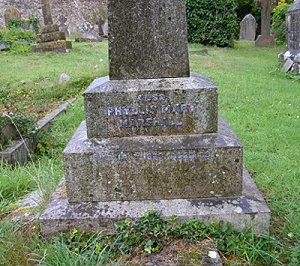
On the Saturday after Christmas in the 1950s, Ms Marshall would invite her Sunday School children to a party at the house. One of the pupils, Keith Burgum of Tutshill, remembers that the party room had other musical instruments and 'fancy dress' costumes.
Mr Burgum remembers her as a strict but kind Sunday School teacher. Although I have been unable to locate a photograph, she is remembered as a rather overweight woman in her 60s, with thick rimmed spectacles. Mr Burgum remembers her determination to make sure that the Sunday school ran one cold winter by walking two miles in deep snow from Offa's Dyke to Tutshill. Apparently she never drove but had a live-in chauffeur on the estate.
Phyllis Marshall remained single at Tidenham until her death in May 1979 aged 89. She spent her last days at the Mount Pleasant Hospital in Chepstow.
However, all the versions found by Phyllis Marshall are different either in text, tune (or both) from Sharp's editions, and are therefore specific to the Bathpool singers. Sharp's notes to The Dilly Song in series four are extensive, and show that he had heard many different versions of it in Somerset. I have no doubt that Phyllis Marshall knew of Sharp's work in Somerset, including versions of the Bathpool songs. Eight of the Bathpool songs can also be found in the Hammond/Gardiner collection in particular from Amos Ash and Jane Gulliver from Combe Florey.
She fits in very well with the pattern of educated Edwardian/Georgian middle class, often religious, collectors whose motivation was to uncover 'lost' English 'folk' culture. She was one of a number of collectors who sent songs to 'main' collectors, in the way that lesser known enthusiasts sent songs and material to, for example, Sharp, Hammond and Baring Gould.
She bears some comparison with Janet Blunt as a collector, in that they were both 'hobbyists' rather than motivated by professional musical interest or driven by a greater 'artistic' agenda. Both Blunt and Marshall, nevertheless, were 'cultured' women with an interest in other arts. Phyllis Marshall's upbringing included musical education, probably centred on her home, church and school. Her mother was church organist. Phyllis followed her example and in Tidenham, she was parish church organist.
She was clearly a conscientious collector and notator of the tunes but the manuscripts reflect the difficulty of oral transcription from source singers. There are several differences of detail between early versions and the fair copies in the Blunt archive.
We can draw some conclusions about her methods from the letter she sent to Janet Blunt in 1917 that accompanied her first batch of songs. Like some of her contemporary collectors she was tempted to 'bowdlerise' texts. Her letter refers to 'imperfect and not quite proper' verses in One night as I lay on my bed and When First to London /London Town, and the versions of these songs in the Blunt archive Volume 10 each miss out a verse. London Town's last verse 'Now this fair maid she is undone, she's got no father for her son…….' was not included in her first manuscript. In One night as I lay on my bed, Phyllis Marshall could not initially persuade herself to send this verse to Janet Blunt:
Although it would be pointless to speculate on her reactions to the meaning of these and other songs, there is no doubt that there must have been some conflict between her role as rector's daughter , and Oxford graduate from a staunch Anglican establishment family, and the more earthy culture of the women in the parish, tempered no doubt by any association they would have had with the parish church and its activities.
The songs noted from Mrs Millington were probably well known in the village; some are essentially children's songs, and may have been taught by her at the school. They may have been 'playground' songs to accompany games. Some of them were published in 19th century collections of nursery rhymes. Whatever their source, Phyllis Marshall did not send these and some other songs to Janet Blunt.
No doubt there were other vernacular songs known in the village. Taunton, a few miles away, may have been seen as a source of 'vulgar' music from the world of entertainment or music hall, although the town had played host to well-known 'high art'/classical musicians in the 19th century.
She was in her mid-twenties, single, presumably well-known and articulate, but of a different social class from and younger than the singers. The only exception was Mrs Millington, the school teacher. It's likely that Janet Blunt was a 'role model' in showing how to collect, how to approach the singers, and what kind of song to 'look for'. This may have included what not to collect. Phyllis Marshall may have invited the singers to the rectory to sing and note down the songs on the piano or organ.
Most of the songs from Bathpool were collected from Elizabeth Nation, the wife of an agricultural worker. She sang 15 songs including versions of The Constant Farmer's Son, When First to London [London Town], Horn Fair, One night as I lay on my bed and Lord Bateman
Many of the Bathpool songs were found in other versions from other Somerset singers, for example, The Female Soldier and The Banks of the Sweet Dundee. Although small in number, these songs stand comparison with other, perhaps more well-known, versions.
Phyllis Marshall can be seen as a 'feeder' collector, like others who sent songs to more important figures like Baring Gould and Sharp. Like many other 'first revival' collectors, she was from an educated, church and middle class background. Her interest in folk song and dance was relatively short-lived, lasting from around 1912 until 1919. There is no evidence of interest after her move from Somerset to Tidenham in Gloucestershire. It seems likely that the 1919 family crisis affected her deeply as a devout Christian, and that she abandoned her interest in her 'hobby' when her priorities were redirected towards her new home and work for the church. Her involvement in music in Tidenham was centred on church life including playing the organ.
Phyllis Marshall deserves to be remembered for her place in the early revival most especially for recording the songs of Elizabeth Nation. Some of these have rightly found their way into print in the New Penguin Book of English Folk Songs. Phyllis Marshall's collection, though small, is therefore an important addition to our understanding of traditional song in Somerset at the beginning of the twentieth century.
In the Full English digital archive, an advanced search under the collection name 'Blunt' will display all the songs in the Blunt archive. An additional search with 'Marshall' as the collector will display all the songs Phyllis Marshall sent to Janet Blunt. They may be found in Volumes 9 and 10 (JHB/9 and JHB/10).
Volume 9 (JHB/9) has these records and songs:
The cover page marked 'Vol 9', 'The Scholastic Music manuscript book'.
In Volume 9, a version of The Female Soldier, (When I was a Young Girl), is attributed to 'Mrs Burge, now dead' (pp.326-7). Mrs Thirza Burge died in 1919 and was buried at West Monkton church in early December that year. Phyllis Marshall therefore sent the second batch of songs to Janet Blunt after December 1919, and many of them were 'repeats' of the songs she sent in 1917. Volume 9 of Janet Blunt's archive dates from after 1919 and Volume 10 is the earlier batch of songs from Bathpool sent in 1917.Phyllis Marshall's 'Loan Books' 1 and 2 were probably both used in 1916-7, from which she selected songs to send to Janet Blunt, in fair copy.
The attribution of When I was a young girl to Mrs Burge may be in error. The Female Soldier is in the second Loan Book and attributed to Mrs Duke of Hyde Lane Bathpool. It is the same song with the same tune and text as When I was a Young Girl. There is no record of any further song collecting by Phyllis Marshall after 1919.
![Extract from a page of Phyllis Marshall's Ms [from 'Loan Book 1'] - her initial transcription of the tune to 'London Town'.](../graphics/philis17.jpg) Phyllis Marshall's tune transcriptions
Phyllis Marshall's tune transcriptionsIn the later version, in Volume 9 of the Blunt archive, the barring is different and the time signature varies between 9/4 and 5/4.This version is the one published in 'Folk Music Journal' Volume 3/2 1976 p156. In 'Loan Book 1' we can see how difficult the oral transcription of this song seemed to Phyllis Marshall….
To the right is an extract from a page of Phyllis Marshall's Ms [from 'Loan Book 1'] - her initial transcription of the tune to London Town, prior to a finished 'fair copy' sent to Janet Blunt in 1917.
There are more minor changes in note values and time signatures between her early loan book manuscripts and the later fair copy versions, for example in Where are you going?, One night as I lay, Lord Bateman and The Seeds of Love. Some of these differences suggest that she had 'second thoughts' when either singing or playing the tunes for later 'editing'. This may reflect the common difficulty of transcription of a free flowing singing style into strict time signatures. Looking at some of the pitches suggests that there are a few inaccuracies; examples are referred in the notes to the song transcriptions below.
At the time of writing (November 2013) the Full English web site at www.vwml.org includes the Janet Blunt archive, with all the songs collected by Phyllis Marshall, but it does not include the songs shown here in appendix 2.
For comparison, here is the version from Jane Gulliver of Combe Florey Somerset, collected in 1905 and included in the H E Hammond manuscript; the tune noted by H E Jeboult.
Spotted Cow
The tune in the manuscript is almost the same as that for Johnny Collishaw, which is two pages before this one in Loan Book 1. It is possible that the tune is in error, as it is very different from the few other collected versions, for example that noted at abcnotation.com. Phyllis Marshall did not include it in her first batch of songs she sent to Janet Blunt, but it was included later in Blunt's Volume 9.
I send herewith the songs I have got so far - there is half a verse of 'The Constant Farmer's Son' which is pure nonsense 'But mark returning home again and said his wife was w??? for by my mistake his life did take of her constant farmer's son'. I believe the song is extant in a broadside pr by Such but hitherto I have not met it. I have had to omit one verse in 'One night as I lay' as it was imperfect and not quite proper and the same with 'And First to London' otherwise they are to all intents as taken down.
We are going to Helston next week for a fortnight or so to stay as p.g's with a cousin and his family who have just gone there to live. I wonder if they danced the furry there this year.
I am hoping to come to Oxford for a retreat from 10-14 September at St Thomas' Convent - but I don't know if I shall be able to manage it. We have just been suffering from a War Savings Campaign in which the main speaker suddenly wrote to say she couldn't come 2 hrs before it was due to start - so I had to speak myself at five meetings. However they were quite successful on the whole so it turned out all right, but it was somewhat agitating. Your songs sound thrilling. I have had to stop collecting for the present but hope to do some more when the tomato mush is over. At present we tie up with fury - I tied up with too much on Friday, got giddy and sat down heavily on the nearest plant - which rather disgruntled the plant. I hope it will recover but we fear not. I weigh a lot.
We have Mr Britten staying with us just now - he is at present reading aloud Chesterton on Dickens'Great Expectations. So excuse incoherence - he is a Roman - a botanical friend of father's and most amusing.
Your dances also sound very nice. I remember how we went and saw that dear old man's dance who sang 'Here's a bunch of sweet roses' and - 'A sprig of shillelagh'
We have a dear old man here who has a version of 'The Golden Glove' which I hope to collect but he is rather difficult to take down from.
I must stop now and play patience with Mr B.
Yours very sincerely
Phyllis M Marshall
Geoff Woolfe - 12.11.13
Article MT289
| Top | Home Page | MT Records | Articles | Reviews | News | Editorial | Map |